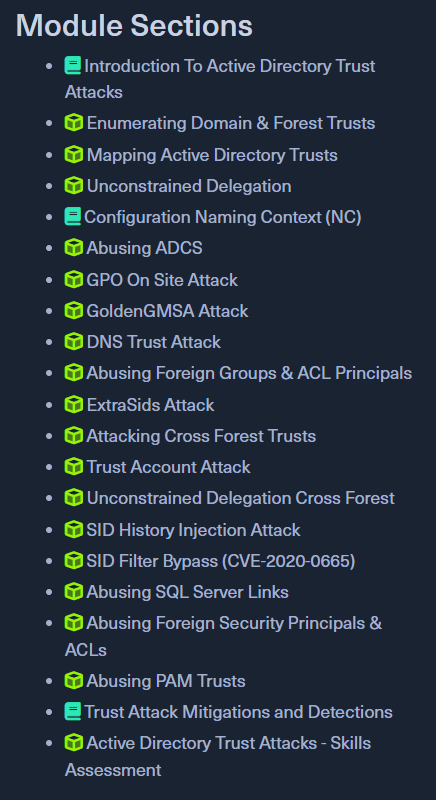Active Directory trusts aren’t just for convenience they’re the secret backdoors most defenders forget to lock. In the wrong hands, they become launchpads for full-domain compromise across forests. This post breaks down how attackers abuse trust relationships and what defenders can do to shut them down.
Quick Overview
Trusts in Active Directory are designed to let domains and forests share resources and users. But here’s the catch: if one side of that trust gets compromised, the attacker may suddenly have a straight shot to total control. These aren’t just edge-case exploits—they’re core to how modern red teams and APTs escalate privileges rapidly across networks.
Whether you’re on offense or defense, understanding trust attacks is essential.
Why Trust Attacks Matter
Picture this: you’re deep in a red team op, stuck in a low-privileged domain with no clear way up. Then you find a trust with another forest. Within minutes, a misconfigured service account in that other domain gives you a ticket straight to Domain Admin. It’s fast, devastating, and all too common.
Here’s why trust attacks are so dangerous in the wild:
- Most enterprises don’t lock them down. A majority of orgs neglect trust hardening altogether.
- They’re high impact. One child domain compromise can cascade into full forest ownership.
- They’re stealthy. Techniques like Golden Tickets and SID filtering bypasses are hard to detect with traditional tools.
- They’re actively used by advanced threat groups. Nation-state actors are already abusing these for cross-cloud and hybrid pivots.
What You’ll Learn
This post walks you through a structured playbook for exploiting—and defending against—Active Directory trust relationships.
I. Trust Fundamentals & Enumeration
We start by breaking down the types of trust relationships: parent-child, forest, and external. The key is understanding which side holds the power—and how attackers map trust paths using standard tools like BloodHound or PowerView.
II. Intra-Forest Attacks
Once inside a child domain, attackers often aim to escalate to the parent. Common approaches include abusing machine account quotas or forging inter-realm Kerberos tickets. Misconfigured ACLs across domain boundaries are another juicy target.
III. Cross-Forest Attacks
This is where things get interesting. Attackers exploit cross-forest trust relationships to jump into external environments. Whether it’s hijacking SID history to impersonate privileged accounts, roasting service accounts across forests, or relaying NTLM via vulnerable certificate services, the techniques are brutal and effective.
IV. Advanced Techniques
In mature environments, the edge comes from more creative angles. Think DNS spoofing to intercept trust-based authentication, bidirectional trust abuse in hybrid Azure AD setups, or crafting Golden Tickets designed to evade modern EDR.
Hands-On Lab: Real-World Attack Simulation
To move from theory to practice, the training lab includes:
- A realistic multi-forest setup with intentional misconfigurations.
- Windows and Linux attacker VMs preloaded with tools like Mimikatz, Rubeus, Impacket, and Certipy.
- Guided exercises simulating real attack chains, from trust enumeration to full forest compromise.
You’ll move through scenarios like escalating from a child domain to the parent forest, forging cross-forest Kerberos tickets, and cracking down on SID filtering weaknesses.
Prerequisites
This module isn’t beginner-friendly and that’s by design. You should already be comfortable with Active Directory basics (Kerberos, LDAP, ACLs), common red team tooling, and some scripting in PowerShell or Python. If you’ve never done AD exploitation before, start with foundational material first.
Final Thoughts & Rating
Rating: 9.5/10
This is hands-down one of the most complete resources on trust-based Active Directory attacks out there. Most cert programs barely touch the topic. This module gives you real-world scenarios, red and blue perspectives, and the lab infrastructure to actually practice.
What stands out:
- Covers over real-world attacks.
- Lab environments mirror real enterprise setups including misconfigured trusts.
- Defensive strategies are baked into each technique, not tacked on at the end.
What’s missing:
- The module assumes strong AD fundamentals newcomers will struggle for sure.
So what can I say about this module in general? Honestly, it was easily one of the top three I’ve enjoyed the most. I didn’t expect it to be this much fun, to be honest.
Given my background and other certifications, I was already familiar with a lot of the techniques covered but there were still a few that surprised me. The GPO-on-site attack, for example, was completely new to me and even though i dont think I will use it that often due too easier ways :D.
Overall, there’s really not much I can complain about. The content was solid, the labs were engaging, and it was definitely worth both the time and money. Highly recommended.
For those interested, here’s a look at the exam table of contents:

